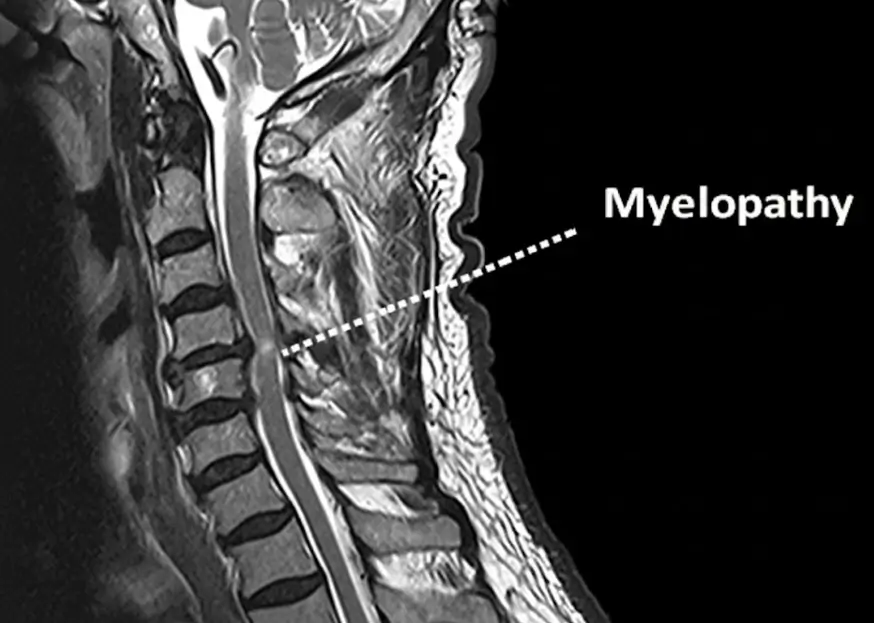- Home
- Spinal Myelopathy
Spinal Myelopathy
- Spinal Myelopathy Specialist
Spinal Myelopathy Treatment in Los Angeles, CA
If you’ve started noticing weakness in your hands, trouble with balance, or stiffness in your legs, it might not just be aging, it could be a sign of spinal myelopathy. This condition develops when the spinal cord itself is under pressure, affecting how your brain communicates with your body.
At our Los Angeles spine center, Dr. Albert P. Wong offers advanced, minimally invasive treatments to relieve that pressure and protect your spinal cord. His approach focuses on restoring function, easing pain, and helping you move confidently again.
- What It Is
What Is Spinal Myelopathy?
Spinal myelopathy occurs when the spinal cord becomes compressed, usually because of changes in the bones, discs, or ligaments surrounding it. This compression disrupts the signals that travel between your brain and the rest of your body, leading to weakness, coordination issues, and even numbness.
Depending on where it occurs, you might hear it referred to as:
- Cervical myelopathy (neck region)
- Thoracic myelopathy (mid-back)
- Lumbar myelopathy (lower back less common)
This condition tends to develop gradually, often as part of normal wear and tear on the spine, but it can also follow injury or disease.

Common Symptoms
Spinal myelopathy can affect people differently, but common signs include:
- Difficulty walking or maintaining balance
- Weakness or stiffness in the arms or legs
- Numbness or tingling in the hands or fingers
- Trouble with fine motor skills like buttoning clothes or writing
- Neck pain or tightness in the shoulders
- Loss of bladder or bowel control in severe cases
Causes & Risk Factors
Spinal myelopathy can result from several underlying issues that narrow or distort the spinal canal. The most common causes include:
- Spinal stenosis (narrowing of the spinal canal)
- Herniated discs pressing on the spinal cord
- Bone spurs from arthritis
- Spinal injuries or fractures
- Tumors or infections affecting the spine
- Degenerative changes from aging
According to the National Institute of Neurological Disorders and Stroke (NINDS) and Mayo Clinic, spinal myelopathy is one of the most common causes of spinal cord dysfunction in adults but early treatment can prevent permanent nerve damage.
Diagnosis & Evaluation
Because spinal myelopathy affects the spinal cord directly, accurate diagnosis is essential. Dr. Wong uses advanced imaging and neurological testing to pinpoint the exact cause and severity of compression. These may include:
- MRI scans, to view soft tissues, discs, and the spinal cord
- CT scans, for a detailed look at bone structure
- X-rays, to check spinal alignment and bone changes
- Neurological exams, to assess reflexes, strength, and coordination
Treatment Options
Treatment for spinal myelopathy depends on how severe the compression is and how much it’s affecting your day-to-day life.
Non-Surgical Treatments:
- Physical therapy, to maintain strength and flexibility
- Medication, for pain and inflammation control
- Activity modification, to avoid movements that aggravate symptoms
While these options can help mild cases, surgery is often needed to prevent worsening nerve damage.
Surgical Treatments:
- Decompression surgery (laminoplasty or laminectomy) removes pressure from the spinal cord
- Minimally invasive spinal fusion, to stabilize the spine
- Disc replacement or corpectomy, when vertebrae or discs are damaged
Dr. Wong focuses on using the least invasive approach possible while ensuring long-term relief and spinal stability.
- Get Appointment
Take the First Step Toward Spinal Myelopathy Relief Today
Schedule a consultation with Dr. Albert Wong in Los Angeles, CA, to explore advanced, personalized treatment options that can help restore strength, balance, and confidence in your everyday activities.
- Faqs
FAQs About Spinal Myelopathy
Learn more about spinal myelopathy; its causes, symptoms, and advanced treatment options offered by Dr. Albert Wong, MD, in Los Angeles.
Yes. Gentle stretching and strengthening exercises can help maintain mobility and reduce stiffness—but they should only be performed under medical supervision.
Recovery varies by patient but often includes physical therapy, activity modification, and regular follow-up to ensure optimal spinal healing and mobility improvement.
While spinal myelopathy can’t always be fully reversed, early treatment can stop progression, relieve symptoms, and improve function and quality of life.
Surgery is typically recommended when symptoms are severe or worsening, as untreated spinal cord compression can lead to permanent nerve damage or paralysis.
Treatment depends on severity and may include medications, physical therapy, and in advanced cases, surgical decompression to relieve pressure on the spinal cord.
